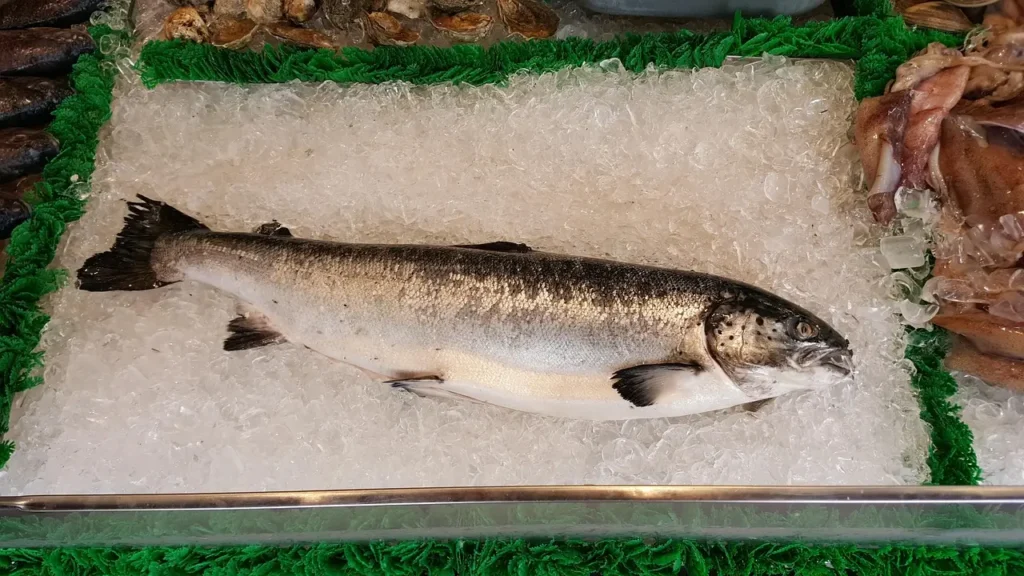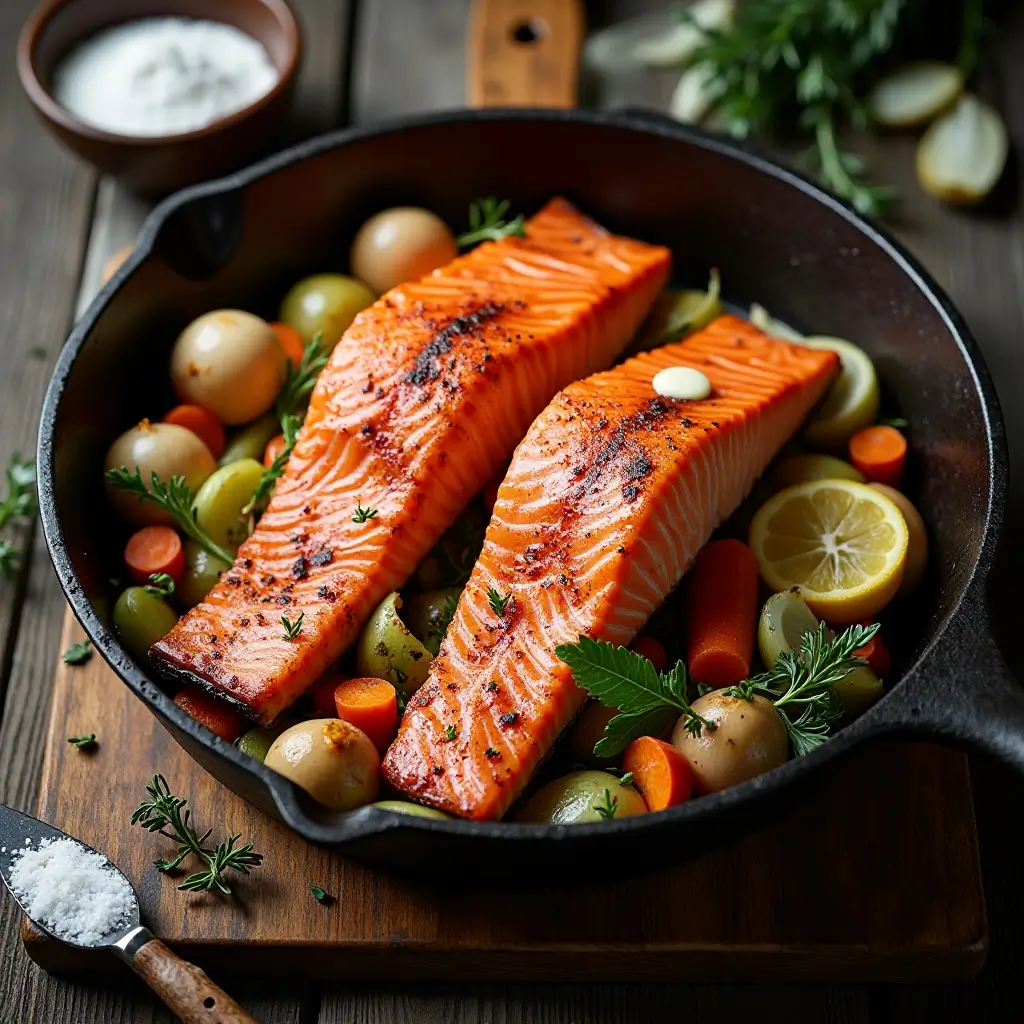Salmon Head Homemade Recipe
Discovering the rich, buttery flavors hidden within a salmon head will transform your perspective on seafood forever. This traditional delicacy offers an incredibly economical way to enjoy premium fish while delivering intense, complex flavors that rival the most expensive cuts.
Many home cooks overlook this nutritious powerhouse, missing out on silky textures and deep umami notes that make every bite memorable.
Similar to our popular whole fish preparations, this salmon head recipe proves that the most rewarding dishes often come from unexpected ingredients, making it perfect for adventurous families seeking both flavor and value.
Table of Contents
What is Salmon Head?
Ever wondered why seasoned chefs guard their salmon head recipes like precious secrets? The salmon head might sound intimidating, but it’s actually nature’s flavor bomb packed with tender meat, rich oils, and incredible nutrition.
Think of it as the crown jewel of the fish – literally the head honcho of seafood delicacies! As the classic saying goes, “the way to a man’s heart is through his stomach,” and nothing proves this more than serving up this surprisingly elegant dish. Ready to become the culinary hero of your household? Let’s dive into this amazing recipe together!
Why You’ll Love This Salmon Head Recipe:
Rich, Complex Flavors That Surprise and Delight
The salmon head contains some of the most flavorful parts of the fish, including the cheeks, collar, and brain cavity. These areas are packed with natural oils and collagen that create an incredibly rich, buttery taste. The meat is surprisingly tender and flakes beautifully, offering a luxurious dining experience that rivals expensive restaurant dishes.
Budget-Friendly Alternative to Premium Cuts
Making salmon head at home costs a fraction of what you’d pay for salmon fillets, yet delivers even more intense flavor. Most fishmongers sell salmon heads at incredibly low prices, making this an economical way to enjoy high-quality protein. You’ll save money while impressing your family with restaurant-quality results.
Nutritious Powerhouse Packed with Benefits
Salmon heads are loaded with omega-3 fatty acids, collagen, and essential minerals that support brain health and joint function. The natural gelatin from cooking creates a silky, satisfying texture while providing incredible nutritional value. Unlike our simple grilled salmon recipe, this preparation maximizes every nutritious component the fish has to offer.
Transform your kitchen into a gourmet seafood haven by trying this incredible salmon head recipe today!
How to Make Salmon Head Recipe:
Quick Overview
This salmon head recipe delivers restaurant-quality results in just 45 minutes of active cooking time. The preparation focuses on simple roasting techniques that highlight the fish’s natural flavors while creating a beautifully caramelized exterior. The key to success lies in proper seasoning and gentle cooking that preserves the delicate textures inside.
Total Time: 1 hour 15 minutes
- Prep Time: 15 minutes
- Cook Time: 45 minutes
- Rest Time: 15 minutes
Key Ingredients for Salmon Head Recipe:
For the Salmon Head:
- 2 large salmon heads (about 2-3 lbs total), cleaned and scaled
- 3 tablespoons olive oil
- 2 teaspoons sea salt
- 1 teaspoon black pepper
- 1 teaspoon smoked paprika
- 1 teaspoon garlic powder
For the Aromatic Vegetables:
- 2 large onions, sliced thick
- 4 carrots, cut into chunks
- 4 celery stalks, chopped
- 1 head of garlic, halved
- 2 bay leaves
- Fresh thyme sprigs
For the Finishing Touch:
- 2 lemons, sliced
- 1/4 cup fresh parsley, chopped
- 2 tablespoons butter
- Coarse sea salt for serving

Step-by-Step Instructions:
Step 1: Prepare the Salmon Heads Rinse the salmon heads thoroughly under cold water, removing any blood or debris. Pat completely dry with paper towels. Using kitchen shears, trim away the gills if still attached. Score the skin lightly in a crosshatch pattern to help seasonings penetrate.
Step 2: Season Generously Combine olive oil, salt, pepper, smoked paprika, and garlic powder in a small bowl. Rub this mixture all over the salmon heads, including inside the cavity. Let them rest at room temperature for 15 minutes to absorb the flavors.
Step 3: Prepare the Vegetable Base Preheat your oven to 425°F (220°C). Arrange the sliced onions, carrots, celery, and garlic halves in a large roasting pan. Scatter bay leaves and thyme sprigs throughout the vegetables. This creates an aromatic bed that infuses the fish with additional flavors.
Step 4: Roast the Salmon Heads Place the seasoned salmon heads on top of the vegetable mixture. Arrange lemon slices around and on top of the fish. Roast for 35-45 minutes, until the skin is golden brown and the internal temperature reaches 145°F (63°C).
Step 5: Rest and Finish Remove from oven and dot with butter pieces. Let rest for 10 minutes before serving. Sprinkle with fresh parsley and coarse sea salt. The resting period allows juices to redistribute for maximum flavor.
What to Serve Salmon Head With:
Perfect Grain Companions: Wild rice pilaf or creamy risotto complement the rich flavors beautifully. The nutty textures balance the fish’s buttery notes while soaking up the delicious pan juices.
Fresh Vegetable Sides: Roasted asparagus, sautéed spinach, or grilled zucchini add brightness and color to your plate. These lighter vegetables provide a refreshing contrast to the rich salmon.
Bread and Starch Options: Crusty sourdough bread or garlic mashed potatoes work wonderfully for soaking up the flavorful cooking liquids. Consider serving with lemon herb quinoa for a healthier alternative.
Wine Pairings: A crisp Sauvignon Blanc or light Pinot Noir enhances the salmon’s natural flavors without overwhelming the delicate taste.
Top Tips for Perfecting Salmon Head Recipe:
Choose the Freshest Salmon Heads Available
Look for bright, clear eyes and vibrant red gills when selecting salmon heads. Fresh fish should smell like the ocean, not “fishy.” Ask your fishmonger to clean and scale them if you’re uncomfortable doing it yourself.
Don’t Overcook the Delicate Meat
Salmon heads cook faster than whole fish, so monitor carefully during the last 10 minutes. The meat should flake easily but still remain moist. Overcooking results in dry, tough textures.
Create Steam for Moisture
Place a small oven-safe dish of water on the bottom rack while roasting. This creates gentle steam that keeps the fish moist and prevents the skin from becoming too crispy.

Let Temperature Guide Your Timing
Use a meat thermometer inserted into the thickest part of the head. When it reaches 145°F (63°C), your salmon is perfectly cooked and safe to eat.
Save the Cooking Liquid for Stock
The pan juices make an incredible base for seafood stock or soup. Strain and freeze for future use in chowders or risottos.
Storing and Reheating Tips:
Refrigerator Storage: Store leftover cooked salmon head in airtight containers for up to 3 days in the refrigerator. Remove any large bones before storing to make reheating easier. Keep the cooking vegetables separate if you plan to use them for stock.
Freezing Instructions: Cooked salmon head can be frozen for up to 2 months when properly wrapped. Remove all meat from the bones, then wrap tightly in plastic wrap and aluminum foil. Label with the date and contents for easy identification.
Reheating Methods: For best results, reheat gently in a 300°F (150°C) oven wrapped in foil with a splash of broth or white wine. Microwave reheating works for small portions – use 30-second intervals at 50% power to prevent overcooking.
Food Safety Notes: Always reheat to an internal temperature of 165°F (74°C). Never leave cooked fish at room temperature for more than 2 hours. When in doubt about freshness, it’s better to discard than risk food poisoning.
Frequently Asked Questions
Is salmon head safe to eat?
Absolutely! Salmon heads are completely safe when sourced from reputable suppliers and cooked properly. They’re considered a delicacy in many cultures and offer excellent nutritional value.
How do I know when salmon head is fully cooked?
The internal temperature should reach 145°F (63°C), and the meat should flake easily with a fork. The eyes will turn white and opaque when fully cooked.
What parts of the salmon head are edible?
The cheeks, collar meat, and flesh around the skull are all delicious. Many people also enjoy the brain and eyes, though these are acquired tastes for some Western palates.
Can I use frozen salmon heads?
Yes, but thaw completely in the refrigerator before cooking. Pat dry thoroughly and allow to come to room temperature before seasoning for best results.
Why is my salmon head dry after cooking?
Overcooking is the most common cause. Use a meat thermometer and remove from heat as soon as it reaches 145°F. The resting period also helps redistribute moisture.
How do I remove the fishy smell while cooking?
Fresh salmon heads shouldn’t smell overly fishy. Rinse thoroughly, soak in milk for 30 minutes before cooking, or add acidic ingredients like lemon juice to neutralize odors.
Nutritional Information
| Nutrient | Per Serving (4 oz) |
|---|---|
| Calories | 185 |
| Protein | 28g |
| Fat | 8g |
| Omega-3 | 2.3g |
| Vitamin D | 645 IU |
| Selenium | 48 mcg |
| Phosphorus | 315 mg |
| Potassium | 425 mg |
Additional Helpful Information
Cultural Significance and Global Variations
Salmon heads are prized in many cuisines worldwide. In Japanese cooking, they’re used for “kabuto-yaki” (helmet grilling), while Russian cuisine features them in rich soups and stews. Understanding these cultural connections can inspire your own creative variations.
Sustainability Benefits
Using salmon heads reduces food waste and supports sustainable fishing practices. When you purchase whole fish or heads, you’re utilizing parts that might otherwise be discarded, making your cooking more environmentally responsible.
Nutritional Powerhouse Details
The collagen in salmon heads supports skin health and joint function. The high omega-3 content promotes brain health and reduces inflammation. These heads also contain significant amounts of vitamin B12, niacin, and phosphorus.
Advanced Cooking Techniques
Try smoking salmon heads for incredible flavor depth, or use them to make rich fish stock that rivals any restaurant preparation. The bones and cartilage break down during long, slow cooking to create naturally gelatinous, nutrient-rich broths.
Shopping and Storage Tips
Build relationships with local fishmongers who can save quality salmon heads for you. Many are happy to provide them at minimal cost since there’s limited demand. Always inspect for freshness and store on ice if not cooking immediately.
This comprehensive guide transforms an overlooked ingredient into a spectacular meal that showcases your culinary creativity while delivering exceptional value and nutrition. Your family will be amazed by the rich, complex flavors hiding in this humble yet magnificent part of the salmon!
